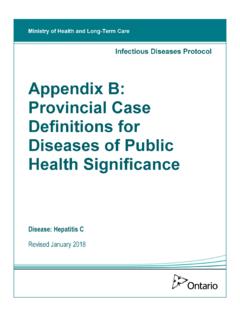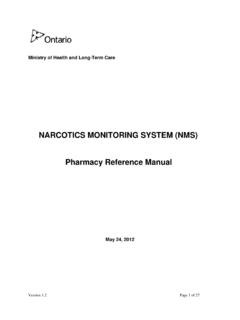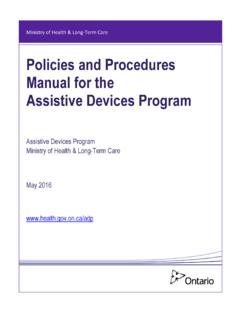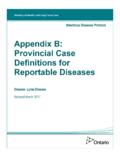Transcription of Appendix B: Provincial Case Definitions for …
1 Ministry of Health and Long-Term Care Infectious Diseases Protocol Appendix B: Provincial case Definitions for reportable Diseases disease : Hepatitis A. Revised March 2017. Health and Long-Term Care Hepatitis A. Provincial Reporting Confirmed and probable cases of disease Type of Surveillance case -by- case case Classification Confirmed case Laboratory confirmation of infection, in the absence of recent hepatitis A vaccination, with detection of anti-HAV IgM. AND. Acute illness with discrete onset of symptoms and jaundice or elevated serum aminotransferase levels (AST, ALT). OR. An epidemiologic link to laboratory-confirmed case Probable case Acute illness in a person with an epidemiologic link to a laboratory-confirmed case Laboratory Evidence Laboratory Confirmation The following will constitute a confirmed case of acute/recent hepatitis A: Serum/plasma sample positive for HAV IgM antibody Approved/Validated Tests Tests for anti-HAV IgM and anti-HAV Total (IgG and IgM) antibody Indications and Limitations Anti-HAV IgM results should be repeated in duplicate to confirm a positive result.
2 Serology tests indicating IgM anti-HAV antibodies confirm recent infection. Antibodies are generally detectable in serum 5-10 days after infection and usually decrease to undetectable levels within 6 months after onset of infection. 2. Health and Long-Term Care In rare cases, they may persist for longer. Acute/recent infection should be confirmed with clinical history, symptoms, and biochemical tests ( elevated serum transaminases AST, ALT, bilirubin, etc.). Reactive anti-HAV IgM serological tests have been reported, in the absence of clinically compatible illness, or epidemiologic links to hepatitis A cases / settings with hepatitis A transmission. This may reflect a false-positive anti-HAV IgM test, due to non-specific cross reactivity in the lab test, presence of rheumatoid factor in serum, or for other unexplained reasons.
3 It may also be due to remote hepatitis A infection as noted above, with persistent anti-HAV IgM, which has been reported. Finally, it may signal detection of inapparent / anicteric hepatitis A. infection. Detection of IgG antibodies signals recovery from acute hepatitis A infection. When IgG antibodies are detected alone they indicate some level of immunity either from past infection or previous immunization. Total hepatitis A virus antibody (total IgM and IgG antibody) is not a confirmatory test for acute HAV. infection but is used as an initial screening test in some laboratories. Following immunization with the hepatitis A vaccine, both IgG and IgM antibodies will appear in serum within two weeks after immunization. AST and ALT generally return to normal before the anti-HV IgM disappears.
4 Clinical Evidence Acute clinical illness is characterized by abrupt fever, malaise, anorexia, nausea and abdominal pain followed by jaundice or elevated aminotransferase levels within a few days. ICD Code(s). ICD-10 Code(s). Hepatitis A with hepatic coma Hepatitis A without hepatic coma [Hepatitis A (acute) (viral) NOS]. ICD-9/ICD-9CM Code(s). Viral hepatitis A with hepatic coma Viral hepatitis A without mention of hepatic coma Comments N/A. 3. Health and Long-Term Care Sources Heymann DL, editor. Control of communicable diseases manual. 20th ed. Washington, DC: American Public Health Association; 2015. Advisory Committee on Epidemiology; Health Canada. case Definitions for diseases under national surveillance. Can Commun Dis Rep. 2000;26 Suppl 3:i-iv, 1-122.
5 Available from: Centers for disease Control and Prevention [Internet]. Atlanta, GA: CDC; 2013. Vaccines and immunizations: hepatitis A vaccination [updated 2013 Feb 7; cited 2014. Feb 16]. Available from: Centers for disease Control and Prevention. Positive test results for acute hepatitis A. virus infection among persons with no recent history of acute hepatitis --- United States, 2002--2004. MMWR Morb Mortal Wkly Rep. 2005; 54(18):453-6. Available from: Kao HW, Ashcavai M, Redeker AG. The persistence of hepatitis A IgM antibody after acute clinical hepatitis A. Hepatology. 1984; 4(5):933-6. Document History Table 1: History of Revisions Revision Date Document Section Description of Revisions March 2017 General New Template March 2017 Sources Updated March 2017 Document History Updated 4.










